Georgia’s Only Travel Guide You Need For A Great Trip in 11 Easy Steps
- Destinations Europe
Cruisit Team
- September 19, 2022
- 1
- 4902
- 71 minutes read

Georgia’s Background
Evidence show that humans first settled in Georgia somewhere between 10,000 and 6,000 BC, according to excavations. After 3000 BC, when the Bronze Age began, the area was inhabited by affluent and powerful cattle-raising tribes that even employed gold and silver in their burial sites. Ancestors of contemporary Georgians first emerged in Assyria and Uratu around 1000 BC, when several tribes like as the Diauhi and the Kulkha ruled the Tao region in southern Georgia and the Black Sea region in the east. The Greeks officially acknowledged Georgia and invaded Colchis Kingdom territory about 700 BC It wasn’t until centuries later that Rome, like the rest of Europe, began to sneak in. Around the first century AD, the Romans took control of the region, and over the next three centuries, Georgia fought on three fronts: against the Romans, the Byzantines, and the Persians. St. Nino brought Christianity to the majority of Georgians in the year 330 AD. Not long after, they were conquered by the Persians. In the 5th century, however, King Vakhtang restored Georgian rule. Nonetheless, there were many rivals for control, including the Byzantine Empire and, in the seventh century, the Arab caliphs, who established an emirate in Tbilisi. It wasn’t until a century later that the Iberian monarchy truly took shape. Georgia’s golden period was from the 10th to the 12th century, when the country was unified east and west and flourished until the arrival of the Mongols in 1220, who wreaked havoc on the Georgians for years. Then the Ottomans and the Iranian Shah appeared in the 16th century and started to compete for power of Georgia. At the end of the 18th century, King Solomon I of Imereti ended Ottoman domination with Russian assistance in exchange for the Georgians fighting against the Ottomans in the Russo-Turkish war, and the Russians never left Georgia alone.
Abkhazia and the Lezgians of Dagestan were the only communities to resist Russian expansion into Georgia at the end of the 19th century; the Lezgians were a group of Muslim tribes that fought valiantly but ultimately lost. Mines, factories, and plantations built by Russian, Armenian, and Western firms during this time period helped propel Georgia’s economy to new heights. On the other hand, civil and political upheaval erupted in the late nineteenth and early twentieth centuries. After the Russian Revolution, during World War I, Russia absorbed Georgia, along with Armenia and Azerbaijan, into the Soviet Union (USSR). Then they had to deal with Stalin’s Soviet regime. Even though Georgia became a metropolitan society and the economy flourished under Soviet administration, the country quickly deteriorated as a result of civil unrest and political instability as well as the Soviet’s collapse. After the Soviet Union collapsed in 1991, Georgia earned its freedom. However, the country descended into civil war until 1993. Between 1993 and 2022, Georgia had a number of presidents, including President Salome, the country’s first female president. Conflicts have arisen often since the Soviet Union collapsed, but today democratization and other changes have been implemented as well as strides to enhance to the economy.
This beautiful country straddles the Caucasus and the Black Sea, standing on the crossroads of Eastern Europe and Western Asia, and sandwiched between Armenia, Russia, Turkey, and Azerbaijan has been contested by several empires for thousands of years, including the Soviet Empire. The climate is so diverse that it falls under 12 clilmatic zones. Despite regaining its sovereignty, Georgia continued to experience interference by Russia, which led to the loss of two provinces and a brief war. Since things seem to have calmed down for the time being, now might be a good time to check out this little nation and see what all the hype is about. Is it for adventure tourism in the subtropical forests and snow peaks with its ecotourism, or the beach holidays on the Black Sea, cuisine tours, hiking the mountains, all of the above or something else?
It could be the tasty cuisine’s aroma and world-class restaurants, or the renowned warmth of the Georgian folks that attract tourists, as locals always seem to invite visitors to their homes, and toast or simply the heartwarming music and thriving dance scene. But if its not that which attracts people to the country, could it be the picturesque city of Tbilisi, with its churches, narrow alleyways, and traditional buildings, not to mention the long historical past. It also could be Kutaisi, or hiking through the villages of Svaneti, and the area surrounding Stepantsminda (Kazbegi) in the Caucasus Mountains is a surefire way to experience this beautiful country. As for the shores, the Black Sea is waiting for you just outside Batumi.
The people’s warmth and their unique language, with the rarest sounds, and unique alphabet is just the tip. Georgia, called Sakartvelo by the people, but linked with St George, hence why it’s called Georgia today, when crusaders, devotees of St Georgia, spread Christianity like wildfire and was the second after Armenia to adopt the religion within its state. Tbilisi’s main square now features a statue of Georgia’s patron saint. Tbilisi’s main square now features a statue of Georgia’s patron saint. The Caucasus Mountains are the most prominent physical feature between Georgia and Russia. Zeus bound Prometheus to one of the mountains, which, in Greek mythology, served as the pillars upon which the world rested. Since 6000 BC, with the first wineries discovered there, and the country has been a major attraction to those interested in the craft. Although Georgia receives few tourists, the country is rich in attractions and history waiting to be discovered. The ranges of verdant valleys dotted with vineyards to ancient churches and watchtowers set on breathtaking mountain peaks are a few of Georgia’s allure.
“Georgia is a tourist’s dream, from its bustling cities to its remote mountaintop viewpoints, there are attractions everywhere, thanks to its legendary past as a crossroads for various civilizations. Explore the wild landscape, feast with the lovely locals, and learn about the region’s fascinating past.”
Tbilisi, the picturesque capital and hippiest town around, has a rich history and architecture, including some contentious new additions to the city skyline, and a nightlife scene that can hold its own with Berlin. The beauty of Georgia, however, is found outside of its urban centers. Much of the country’s breathtaking vistas have not been disturbed because to the country’s nine national parks and numerous more natural reserves and “protected areas.” From the towering peaks of the Caucasus to the spectacular forest-backed beaches of the Black Sea coast, Georgia will keep you on your toes. There has never been a better time to go, as there are more flight options than ever before and several exciting new hotels to choose from. The variety of attractions but also accommodation means that everyone is welcome from the fellow backpacker wanting to visit Georgia to the luxury seeker. This is a country that was a backpacker’s secret destination, however, now it gaining traction along all the different travelers that are welcomed by the heartwarming and hospitable locals. Gaumarjos!
Staying on the move will allow you to take advantage of all that Georgia has to offer visitors. This Cruisit Georgia travel guide provides an itinerary that strikes a balance between leisure and exploration. Arrive in this untapped paradise in the Caucasus, both in Europe and Asia, and enjoy it to the fullest. The following itinerary for Georgia is tailored to the country’s peak tourist season, but is best enjoyed during the shoulder months. With sunny days spent in ancient parts of town in the company of legend, or surrounded by verdant peaks and dramatic picture-perfect scenery, and tens of species to spot while exploring on your hikes, Georgia will fulfill your wildest dreams.
Moreover, we will provide you with all the information you need to go across Georgia with ease by providing you with a comprehensive travel guide. As you read on, you’ll learn about the best of what Georgia has to offer—its cities, sights, transit options, and more. If you’re pumped up enough, then let’s get started!
- Start at the capital city of Tbilisi and see its historic district, castles, churches, and marketplaces, or take a leisurely stroll along the river.
- Located in Georgia, Mtskheta is the World Heritage site and the seat of the Georgian Orthodox Church.
- Visit the Tsminda Sameba Church on your journey up to the Gergeti Glacier or Mount Kazbek.
- After gawking at Stalin’s enormous statue at Gori, his birthplace, you may visit the Stalin Museum there.
- Tour the Kutaisi area’s World Heritage monuments, including the Bagrati Cathedral and Gelati Monastery.
- Travel to the western Caucasus Mountains and visit the Svaneti area, where ancient settlements with defensive towers are situated against breathtaking scenery.
- Batumi is a fun place to spend some time, both during the day and the night.
- Caving in Vardzia’s fresco-adorned caves is a must.
- In the Caucasus, skiers may visit Pasanauri or the Bakuriani ski resorts.
- Kakheti is a great place to sample Georgian wine if you’re in the mood (and not too inebriated) after been urged to do so repeatedly throughout your time in Georgia.
- Since almost half the world (94 countries) do not need a visa to enter Georgia, with stays up to a year without a visa, it is a great place to begin seeing the countries that were formerly part of the Soviet Union. But you should always double-check before booking.
- There is a shortage of people who can communicate in English. Georgian is the language spoken by the people of Georgia; it is a distinct language with no close relatives. If you want to learn Georgian but are having trouble deciphering the letters, a dictionary or phrasebook might come in handy. Learning Russian will help if you travel to any of the former Soviet Republics, as the language is still widely spoken there.
- Georgians are known for their warm hospitality, so don’t be surprised if you’re asked to someone’s home many times for meals and beverages. Not being able to join in on the toasts and drinks is challenging for those who abstain. Be kind yet firm when saying no.
- Be wary of taking a taxi in Georgia, since it is not unusual to be picked up by a driver who is completely intoxicated due to the prevalence of heavy drinking culture.
- Abkhazia and South Ossetia are two breakaway areas of Georgia that are only recognized and protected by Russia. These regions may only be accessed from the Russian side of the border.
- Learn how to navigate the local public transportation system. There are both railways and marshrutkas (a type of minivan) for travel.
- Take the time to study some simple Georgian phrases. For both “hello” and “thank you,” you should use the gamarjoba pronunciation.
- Take your time exploring the nation’s capital. Tbilisi is worth your time, so don’t rush through it.
- If you plan on using cabs in Georgia, you should probably bring a sim card. Also, stick with Taxis available via apps (and never taken from the airport).
- For extended car trips, try using gotrip.
- Always watch out for your safety on the roads, because driving in this area is crazy.
- While tourist scams and corruption are uncommon in Georgia, visitors should always come prepared with cash.
- Tbilisi is notorious for waking up late in the day and staying late at night philosophy.
- While the warmth of a guesthouse’s welcome may do wonders for the spirit, every once in a while it’s wonderful to indulge in a bit of opulence.
- Always double-check the actual opening times before planning your trip.
- A minimum of one trek is a must, must, must!
- Be wary of monastery fatigue; with so many monasteries to choose from, it’s easy to lose steam quickly, as well as interest.
Crime & Scams in Georgia
Tbilisi, the capital of Georgia, is often regarded as one of the world’s safest cities. But, Georgia as a whole is a relatively safe destination for tourists, with one of the lowest crime rates in all of Europe. Although crime and corruption were formerly major problems in Georgia, they have been nearly eradicated. The problem of scammers, however, is not unique to Georgia; it occurs everywhere. The most popular types of scams in Georgia are those involving credit cards and the Internet. Never pay anything in full without first haggling for a better price, and always verify your change. Do not let strangers pour you a drink or leave your drink unattended. Be wary of your possessions in the Tbilisi metro and on public transportation, where pickpockets operate, although these crimes are not common.
Violence against tourists is quite uncommon in Georgia, thus single women visitors should feel comfortable exploring the nation. The only trouble spots are in the northern regions of Georgia (Abkhazia and South Ossetia), which are occupied by the Russian Federation.
Be especially cautious if you are in public places frequented by foreigners, near official buildings, popular tourist sites, or on public transit. Avoid going to slum regions of the city. Take extra precautions on city streets, especially after dark or if you are alone. Carry no significant sums of money or wear expensive watches or jewelry. Avoid using your phone while walking down the street.
Healthcare in Georgia While Traveling
More than 90% of Georgians have access to publicly financed healthcare, and the government has established a public health policy basis by establishing a universal healthcare program. On the other hand, well-equipped private hospitals are also available, and its patients can pay for their care using private health insurance. As of the year 2020, Georgia is home to 187 hospitals, the majority of which may be found in the capital city of Tbilisi. You won’t have any problem receiving acceptable medical treatment in Georgia if you’re visiting the country on a tourist visa; nevertheless, you will be expected to pay for it. Most hospitals have English-speaking staff and physicians.
Before every trip, make sure you are up to date on all routine vaccinations. Among the key recommended vaccines globally are yellow fever, chickenpox (Varicella), diphtheria-tetanus-pertussis (DTP), influenza (flu), measles-mumps-rubella (MMR), polio, hepatitis, typhoid, and shingles. If you will be in contact with wildlife, you may want to consider getting a rabies vaccination.
When visiting Georgia, you are legally required to purchase travel medical insurance. So, it is always important to have comprehensive medical coverage when traveling because you never know what you could encounter while overseas, especially if in the event of an emergency, a medical evacuation is a must for your safety.
Only eat foods that are cooked and served hot, avoid food that has been sitting on a buffet, and eat raw fruits and vegetables only if you have washed them in clean water or peeled them.
Only drink beverages from factory-sealed containers, avoid ice because it may have been made from unclean water, and only drink pasteurized milk.
Wash hands often with soap and water for 20 seconds, especially after using the bathroom and before eating. If soap and water aren’t available, use an alcohol-based hand sanitizer that contains at least 60% alcohol. Also, keep your hands away from your face and mouth.
As long as you stay away of the nation’s higher altitude mountain regions, Georgia has a pleasant temperature. The climate in western Georgia is subtropical, while the climate of eastern Georgia is dry and slightly continental. While there isn’t a best time to visit Georgia, since it is great all year round, but there is definitely a time to avoid, in the height of summer for those who dislike the crowd, and the peak winter, for those who don’t like it freezing. It rarely reaches -6°C (20°F) or above 36°C (97°F) over the course of the year.
Shoulder Season
April, May and October are the shoulder months in Georgia where the temperatures start to adjust towards the coming season. In April and May the weather starts to become warmer, but while it may still rain, as it starts to shift to a more dry climate. Flowers start to bloom throughout April and May. Like September, October still offers great weather in the lowlands, like Tbilisi, however, it is when autumn colors have taken over. The weather in the fall is perfect for sightseeing and the vineyards are at their peak. People take advantage of the comfortable weather of the shoulder months which makes outdoor activities like hiking a breeze compared to summer. Average temperatures in Georgia during the shoulder months see highs of 26°C (79°F) and lows of 6°C (43°F) and sometimes lower. The biggest advantage to traveling in the shoulder season is not only the fewer crowds that the country sees, but also the more affordable accommodation and overall cost of traveling to Georgia.
High (Peak) Season
The peak season in Georgia stretches from June to September, while for Georgiansstart vacatiioning in July and August, when hotels and other accommodation options are fully booked. During these times, Tbilisi and the lowlands can get uncomfortably hot. Aside from being the only time of year when trekking in the Caucasus is likely to be completely free of snow, this season is also a pleasant one in the mountain regions. You can avoid the summer crowds while still enjoy comfortable weather by visiting Georgia’s mountains or head to the countryside and hills for cooler weather. Unless skiing is what you want to do, this is the time of year to go to Georgia and enjoy its many attractions, but especially June and September. June see flowers in full bloom, especially in Svaneti and Tusheti, in the High Caucasus, and September sees the fall colors slowly emerge, and in between June and September is hot weather, however, temperatures are more manageable during certain times of day. Accommodations are more expensive overall, but can be significantly more expensive near the Black Sea. Transportation and lodging services see peak demand throughout the summer months, so it is recommended to book in advance.
Off-Season (Low Season)
The low season in Georgia stretches from November to March, although December could some crowds with Christmas and New Years. While September could see some snowfall in the mountain regions, it truly snows starting November. Extremely cold weather typically arrives in December, January, and February, and perhaps even March, which is why it is the off season, since temperatures drop below freezing. But, this is also the time of year when many people visit ski resorts, and many public celebrations take place. However, if you’re not interested in winter activities, you should probably avoid Georgia. During these low season months, Georgia sees its lowest prices on accommodation and flights which can be really appealing for backpackers and budget travelers.
By Plane
The major airport in Georgia is Tbilisi International Airport, which is located in the capital city. Tbilisi is accessible through direct flights from 56 airports in 52 different cities in 29 different countries. National carrier Georgian Airways flies to and from cities including Amsterdam, Moscow, Paris, Baku, Istanbul, and Vienna on a regular basis, however Wizz Air offers more travel options. To go to Georgia from the UK, you can take one of several indirect flights provided by airlines including Aeroflot, Turkish Airlines, and Ukraine Airlines. Also, approximately 30 other airlines provide indirect flights to Georgia from all around the world.
By Train
Tbilisi is linked to both Baku, Azerbaijan and Yerevan, Armenia through train. In other words, while arranging a vacation to Georgia, you should consider taking some time to see the surrounding countries as well. There is a train that travels the 14 hours between Baku and Tbilisi for around $20. You may take a train from Yerevan to Tbilisi in 11 hours for as little as $19 and as much as $90. Although it is theoretically conceivable to take a train from Istanbul to Tbilisi via several intermediate stations and two days, the expense of such a journey is astronomical in comparison to that of flying, which takes less than three hours and costs a fraction of the price.
By Car
Azerbaijan, Armenia, Russia, and Turkey all share land borders with Georgia, but you should stay away from the area that borders Russia to prevent any potential political conflicts. The drive from Yerevan, Armenia, to Tbilisi, Georgia, takes around 4 hours. If you are coming from Baku, Azerbaijan, it will take you around 8 hours to get to Tbilisi. The trip from Istanbul by automobile takes 21 hours and is quite picturesque, but only the most dedicated road trippers would undertake it.
By Bus
The cost to take a bus from Yerevan, Armenia is about $25, and the trip takes about 7 hours. You may take a bus from Baku to the border town of Qırmızı Körpü, where you can then rent a vehicle for around $18 and continue on to Tbilisi. From Istanbul, there are buses available; however, the trip takes an unreasonable 29 hours and can cost as much as $50, depending on the number of stops and transfers.
By Boat
UKRferry operates ferry service between Varna (Bulgaria) and Chernomorsk (Ukraine) and Poti (Georgia) and Batumi (Georgia) for $140. A boat ride to Georgia from Romania requires a stop in either Varna or Chernomorsk. From both Varna and Chernomorsk, the journey will take you close to two days. Due to the high price and lengthy duration of the voyage, the only plausible justification for embarking on such an adventure would be to experience life on a ship. However, you may go to Georgia just as quickly and for much less money by taking an aircraft instead of a boat.
Larger cities in Georgia are served by buses, mini-buses, and taxis. Tbilisi is the only city that has a metro system. Between the two underground metro lines, the city bus and minivan network, three cable car ropeways and the funicular, you can get just about anywhere you need to go using public transport in Tbilisi. In rural areas, you will have to rely on a rental car, private transport, taxi, trains, buses, or a guided tour.
By Plane
Both Tbilisi and Batumi have airports where you may get a flight. Since plane tickets might cost anything from 215 GEL to 1,078 GEL, this is not the most cost-effective choice. You need to be really interested in convenience and have a very large disposable income before we suggest it. Traveling by plane won’t be more efficient in Georgia because of the relatively short distances between cities.
By Train
Within Georgia, rail travel is delayed since most trains are outdated, and they also lack air conditioning. It is recommended to reserve your train ticket at least two days in advance during peak travel times if you intend to use the train.
There are direct train services into and out of Georgia from both Armenia and Azerbaijan. Tickets for the overnight train from Baku, Azerbaijan, to Tbilisi start at only 62 GEL. Due to the length of the trip (about 13 hours), first class could be a good investment (around 100 GEL).
By Car
Renting a car is a convenient method to go about Georgia. In this way, you’ll have complete freedom of movement. Car rentals start at 94 GEL per day when you book for more than three days. You should exercise caution on the roads in Georgia because they are far from ideal and accidents are prevalent. Vehicle rentals call for an IDP (International Driving Permit).
By Taxi
There is a minimum fare of roughly 3 GEL for a cab, and the going rate is about 0.60 GEL per kilometer. Always agree on a price in advance. Yandex, Georgia’s version of Uber, is another option if you’re in Tbilisi and don’t feel like taking the bus. The apps can be downloaded and used to schedule a ride with a driver. For the most part, you won’t have to pay more than 5 GEL for a ride. The available apps are Taxi Tbilisi, Bolt, Maxim Taxi, Smart Taxi, Taxi.Ge, and Yandex Go, but you will need a Georgian sim card.
By Bus
Local buses (called marshrutkas) are the most cost-effective method of transportation inside the country. The fare for a trip from Tbilisi to Yerevan, Armenia, is 35 GEL.
By Metro
The Tbilisi metro operates daily (including Sundays and holidays) between the hours of 6 a.m. and midnight, with two lines traversing the city and charging a fixed rate of 1 GEL for all rides, no matter the final destination, the distance traveled, or the time of day. Tbilisi Travel Cards are available on a daily, weekly, or monthly basis, and can save travelers a significant amount of money depending on how long they want to stay. If you haven’t already, you may buy a blue card at any metro station with the “MS” symbol or at any Bank of Georgia Express branch, and then use it at one of the orange, self-service, ATM-like machines to subscribe to the passes.
SIM Cards & Calls in Georgia
Geocell, Magti, and Beeline are the three most popular mobile internet providers in Georgia. The aforementioned mobile internet service providers all have substantial footprints in the major cities of Georgia and at the airports of Batumi, Tbilisi, and Kutaisi. You may just walk into any store and ask for a sim card in Georgia; the personnel there is quite helpful and will likely speak English with you. From Geocell, you can purchase a 15-day plan with up to 3 GB of data, unlimited calling, and unlimited texting for as little as 20 GEL ($6). Beeline charges 25 GEL for the same bundle whereas Magti charges 30 GEL. Magti has the finest 4G and 5G coverage, however their services might be more expensive.
Alternatively, you may also get a prepaid eSim card from companies like Airalo, SIMCorner, HolaFly, or Nomad. All the providers offer data-only plans that may be used with an eSim-enabled phone, so make sure your phone is compatible. It is also possible to sign up for a Solis WiFi Hotspot. Check before you travel because they only serve select areas. Airalo provides the most extensive coverage of over 180 nations.
Local Internet & WiFi in Georgia
Almost everyone in Georgia has access to the web, and speeds are comparable to or even better than those in the rest of the European Union because to the prevalence of fiber optic connections and the widespread use of digital subscriber line (DSL) technology. Even if the connection is slow, you can access the internet no matter where you are. Wi-Fi may be accessed for free in many public venues, including cafes, restaurants, and hotels. More so, these days you can stay in practically any hotel or other lodging and still have access to free wifi. Rates might be as high as 100 Mbps and can range from as low as 20 Mbps.
Top Places in Georgia

Ushguli
Ushguli is a small cluster of settlements in the Svaneti area of the Caucasus Mountains. After over five years of continuous travel across the world, I can declare with confidence that Ushguli is one of the most wonderful sites to visit, not just in Georgia but in all of Europe. This otherworldly UNESCO World Heritage Site is surrounded by sharp, intimidating mountains, and is guarded by dozens of antique watchtowers.
Narikala Fortress
The old fortification of Narikala looks out over modern-day Tbilisi and the Mtkvari River in Georgia. Set on a hill between Tbilisi’s thermal springs and botanical gardens, the castle comprises of two walled parts. The St. Nicholas Church, recently renovated, sits on the lower court. The ancient church from the 13th century burned down, and this one dates back to 1996–1997. Doors may be found on all four sides of the “prescribed cross” design of the new church. The inside of the church is painted with frescoes depicting episodes from the Bible and Georgian history.

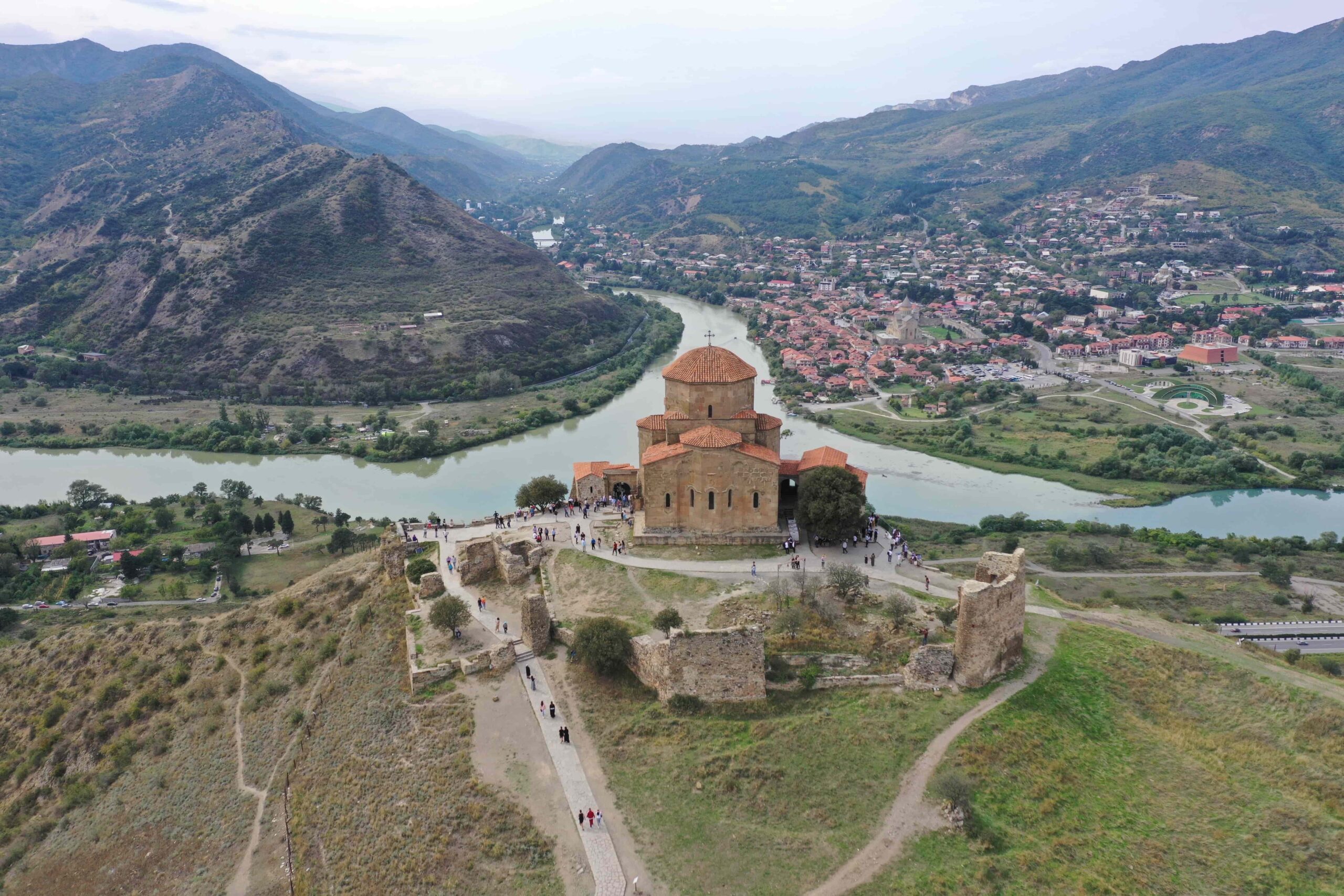
Jvari Monastery
Located in eastern Georgia close to the city of Mtskheta, the Jvari Monastery dates back to the sixth century. When it comes to Georgian churches from the Early Middle Ages, Jvari is one of the few that has remained essentially intact to the current day. Located on the crossroads of Georgia and Armenia, this church is considered the prototypical example of the Jvari style of church construction. The monastery, perched atop Jvari Mount, is a prime example of the medieval Georgian architectural style known for its seamless integration with its natural surroundings. The monastery and other ancient buildings in Mtskheta were added to the UNESCO World Heritage List in 1994.
Ali & Nino Statue
The Ali and Nino is a prominent sculpture which was created by artist Tamara Kvesitadze to tell the story of love between a Christian princess and a Muslim boy who were forced to separate from each other during the Bolshevik invasion. The 8 meter long steel statue is sitatued in the coastal city of Batumi, by the sea.


Holy Trinity Cathedral
Commonly referred to as “Sameba,” the Holy Trinity Cathedral of Tbilisi is the major cathedral of the Georgian Orthodox Church. Built between 1995 and 2004, this massive cathedral ranks as the third-tallest Eastern Orthodox cathedral in the world. The sameba style, which has some Byzantine overtones, is a fusion of the traditional forms that have dominated Georgian church construction at different times in history.
8-day Itinerary in Georgia
Day 1
Arrive in Tbilisi
Tbilisi, Georgia, the country’s capital, is a thriving metropolis with historic buildings alongside modern ones, natural hot springs, and a wide variety of cafes to choose from. Once you’ve arrived, take your prebooked transport, a taxi (from one of the apps), or
Get your day going with a stroll down Rustaveli Avenue, the city’s main thoroughfare, and end it at Liberty Square. Along the journey, you may admire the Opera House, the Rustaveli Theater, and the Parliament building, all of which are decades old but have just undergone extensive renovations. When you reach Liberty Square, the central statue of St. George will be your first point of reference.
Keeping going down Kote Abkhazi street would take you to the Old Town. Most of your time will be spent meandering around the maze of winding cobblestone alleys and gazing up at the intricately carved wooden balconies of the historic homes. In the evening, ride the ropeway up to Narika Fortress and Mother of Georgia to take in the cityscape.
Also don’t miss the bizarre clock tower while you’re in Tbilisi’s Old Town, and when you’re done pass by the Chronicles of Georgia, a stunning, modern, monument erected in the late 20th century made of stone pillars and overlooking a reservoir. The structure portrays prominent characters including Jesus, as well as other notable figures.
Visit one of Georgia’s spas in Abanotubani if you’re interested in soaking in natural hot springs; when you get hungry, don’t forget to sample the region’s signature dish, Khinkali.

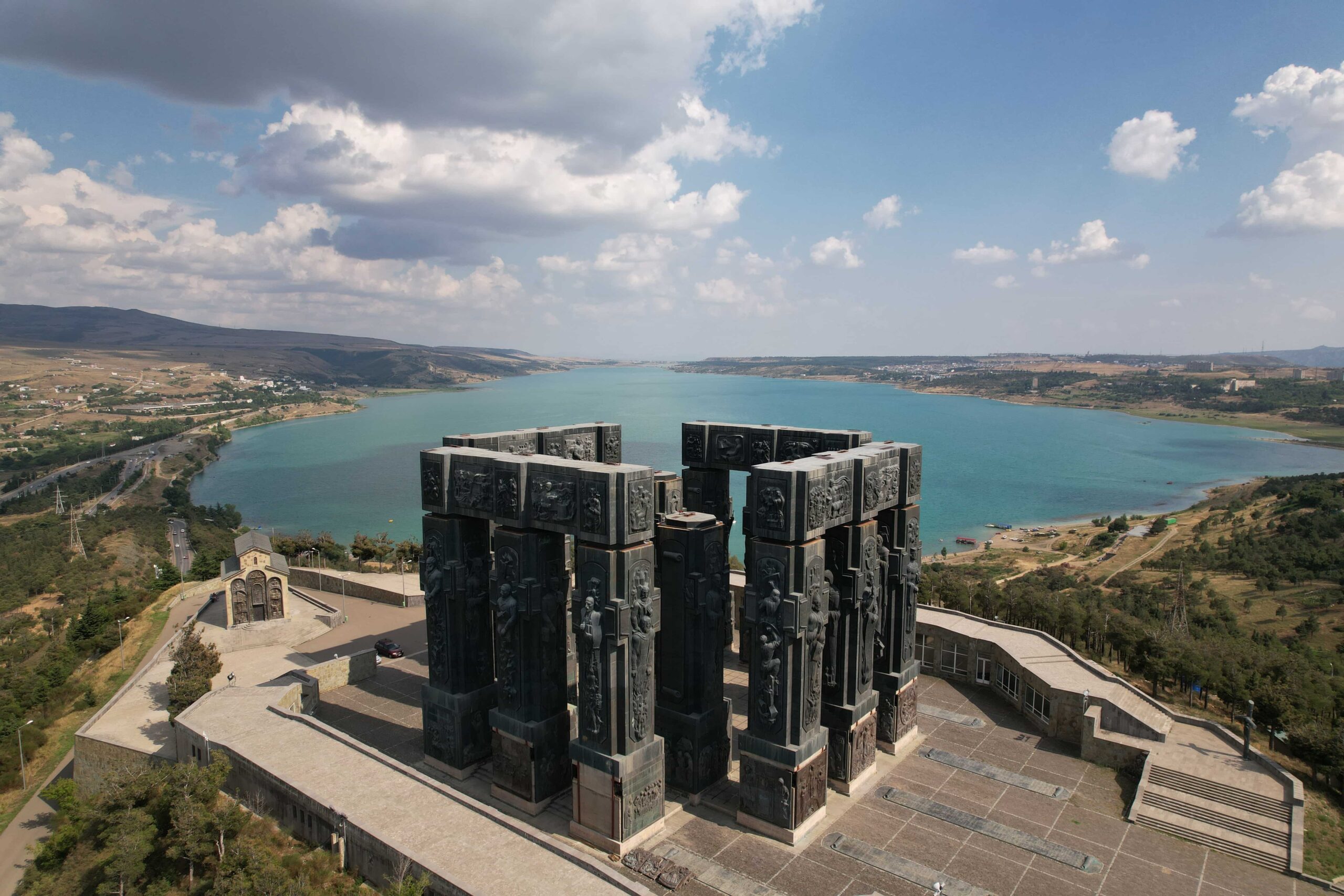

- Backpacker:
- Budget:
- Mid-range:
- Luxury:
When it becomes dark, a foreign city may be twice as dangerous - especially if you don't understand the language and are unfamiliar with the area. There is little reason to be alarmed about walking alone in the city since there low crime rate in Tbilisi and some of the only crimes are pickpockets. You can walk safely at day, but be wary while walking at night and be alert in crowded areas or unlit alleys or streets. You can always take taxis, if you don't feel comfortable, Be wary of petty crime by taking precautions mentioned in the safety section above.
Day 2
Exploring David Gareji and Sighnaghi
Towards the border with Azerbaijan, in the Kakheti province, is where you’ll find the David Gareji monastery complex. One of the 13 Assyrian Fathers who brought Christianity to Georgia erected the complex in the sixth century CE.
Sighnaghi or Signagi is a hilltop town with stunning 18th and 19th century buildings. The town’s red-roofed timber homes, set against a background of the Caucasus Mountains, and its cobblestone lanes contribute to its reputation as one of Georgia’s most endearing.

Day 3
Historical Round
Mtskheta, Georgia, is about a half-hour drive from Tbilisi and was once the country’s capital. The city’s primary attraction, Svetitskhoveli Cathedral, can be seen in less than an hour due to its proximity to the city center. Continue onward to Gori and Uplistsikhe from here.
Uplistsikhe is a monolith cave-town spread across eight hectares of ground, whereas Gori is the birthplace of Joseph Stalin and home to his house-museum.
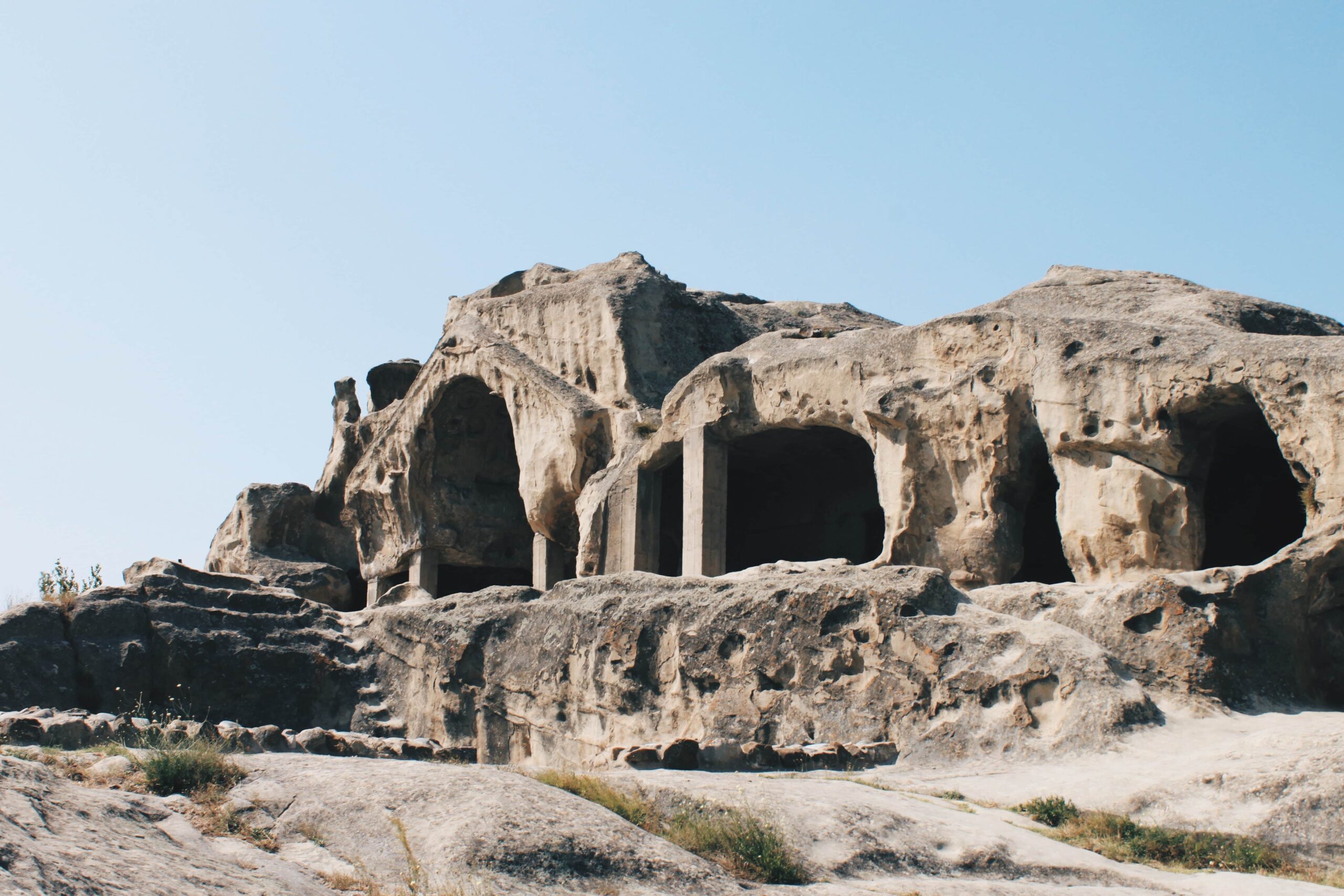
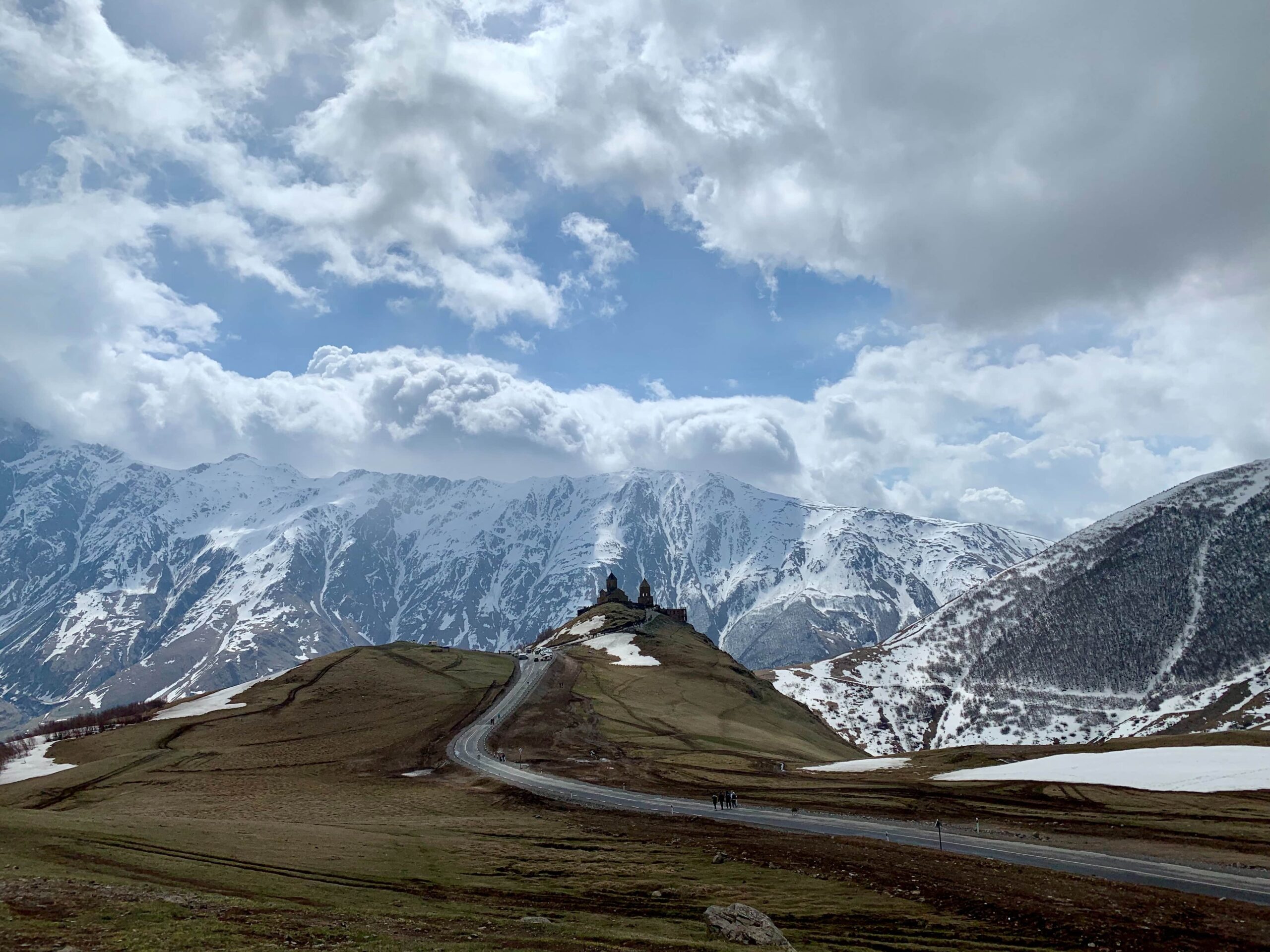
Day 4
Stepantsminda
Visitors also go to Stepantsminda, a little town not far away. Tourists come to see the Gergeti Trinity Church, which is the only significant attraction in town. The building sits on top a hill facing the beautiful scenery of the mountains. In winter, the mountains are covered with snow and in spring the verdant vistas give a heartwarming feeling.
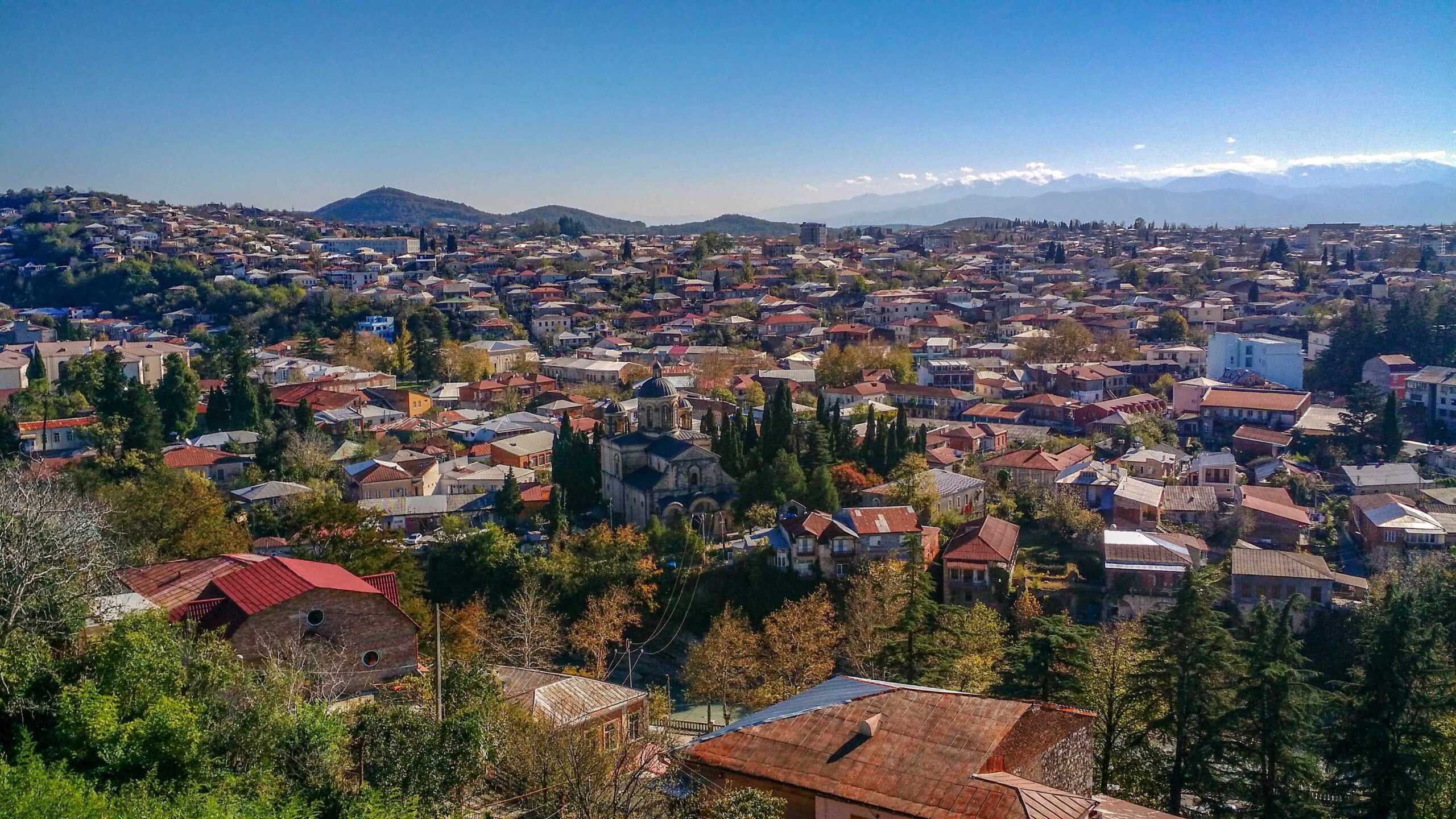
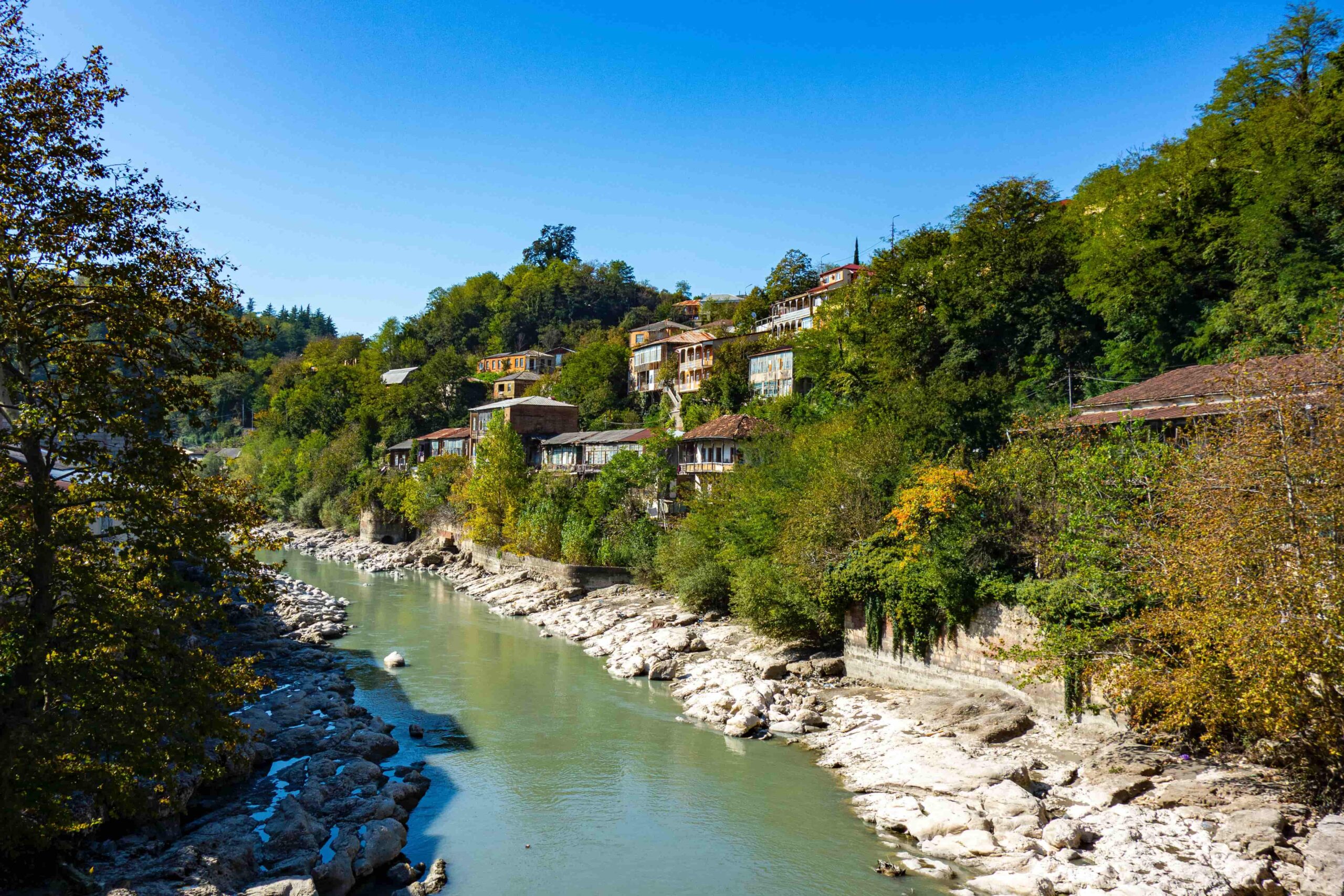
Day 5
Off to Kutaisi
Another one of Georgia’s ex-capitals is Kutaisi. Bagrati Cathedral, a masterpiece of Georgian architecture from the Middle Ages, dates back a full eleven centuries and is recognized as a UNESCO World Heritage Site. Gelati and Motsameta monasteries, as well as Sataplia Nature Reserve, are two other must-see destinations.
Former president Mikheil Saakashvili had a brand new, state-of-the-art edifice constructed in Kutaisi for the Parliament. Although this six-story glass dome was officially opened in 2012, the sessions of Parliament were relocated back to Tbilisi the following year after several lawmakers voiced their displeasure with the choice and a new government took power.
Aside from politics, make sure you stroll around the Rioni River and see the beautiful scenery there before you head back to your lodgning.
Days 6 to 7
Beachside
Batumi, one of Georgia’s major coastal cities, is frequented by residents and tourists alike during the warm summer months. The revitalized city is home to a plethora of exciting attractions. Some of the city’s most famous landmarks may be found within easy walking distance from one another along the Boulevard. The statues of Ali and Nino, the Alphabetic Tower, Piazza Square,, and Europe Square are only some of the attractions in the area.

Day 8
Last Day
This Georgia itinerary gave you a quick look into the people’s lives and the region’s deep history. If you haven’t left the day before to the airport, today is the promised day. Now, if you still have time, you can stroll around Tbilisi for one last time before your flight. Otherwise, head to the airport immediately upon arriving in Tbilisi.
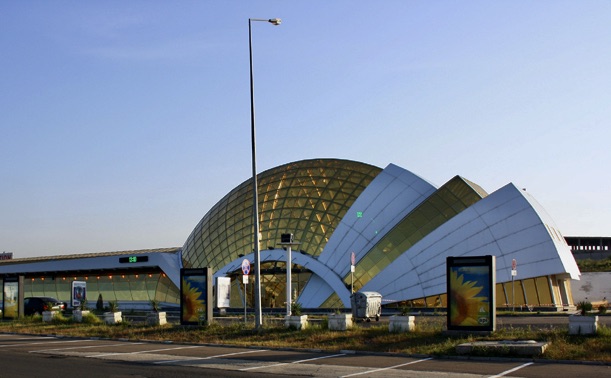
The Most Popular Food in Georgia
People all around the world, not just those who call Georgia home, have learned to appreciate and value the country’s traditional cuisine. Many of our most well-liked classic dishes may now be found on the menus of any of the hundreds of Georgian restaurants spread around the globe. But Georgian cuisine has its roots and inspirations in Iran, Asia, Turkey, and much of the Mediterranean, and it has evolved over time to take on a flavor of its own.
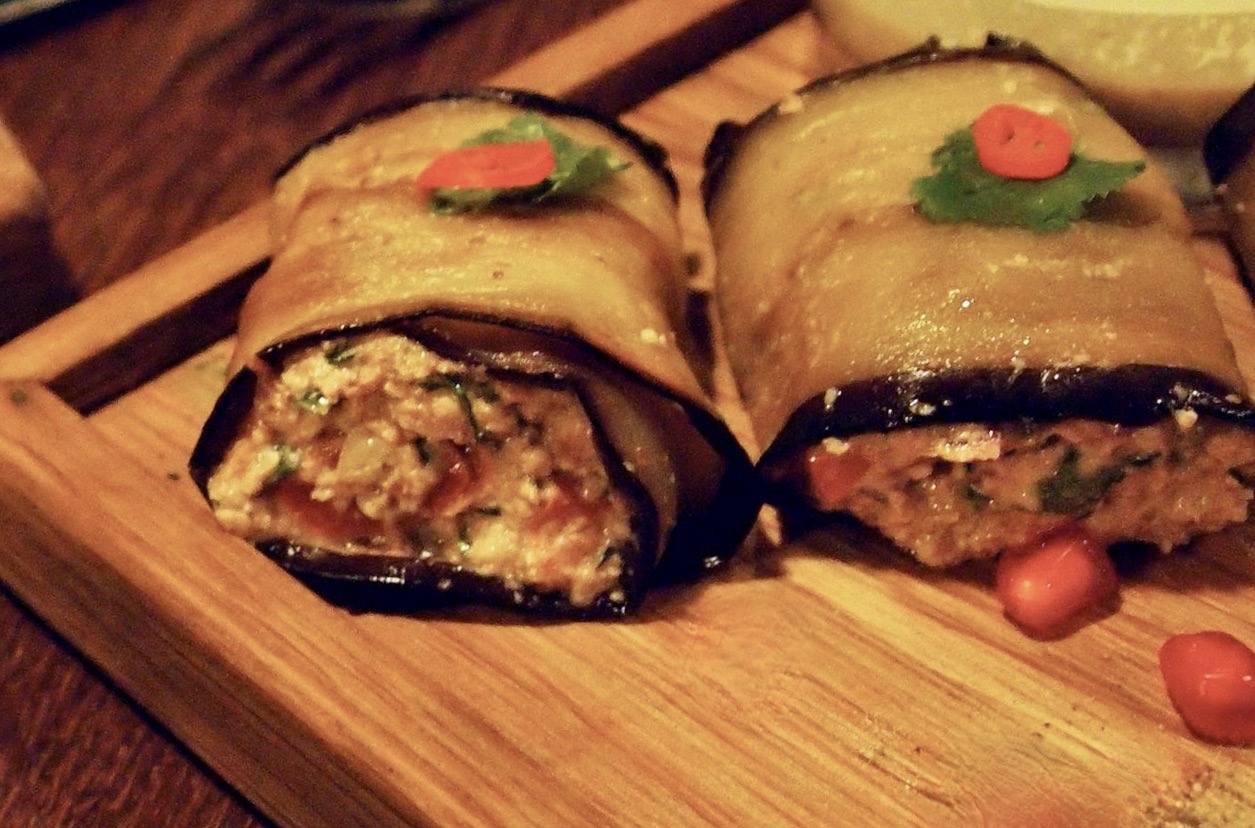
Badrijani Nigvzit
Eggplant, also known as badrijan, is first sliced into strips, then roasted, and finally served on a flat surface with walnut paste on top. This dish, which features a delicious balance of sweet and salty ingredients, is routinely ranked as one of our top picks.

Pkhali
Think of it as a form of vegetable paté; it’s a colorful meal cooked with mashed vegetables such as beets, spinach, and carrots blended with walnuts, garlic, and other spices. You may think of it as a kind of paté.
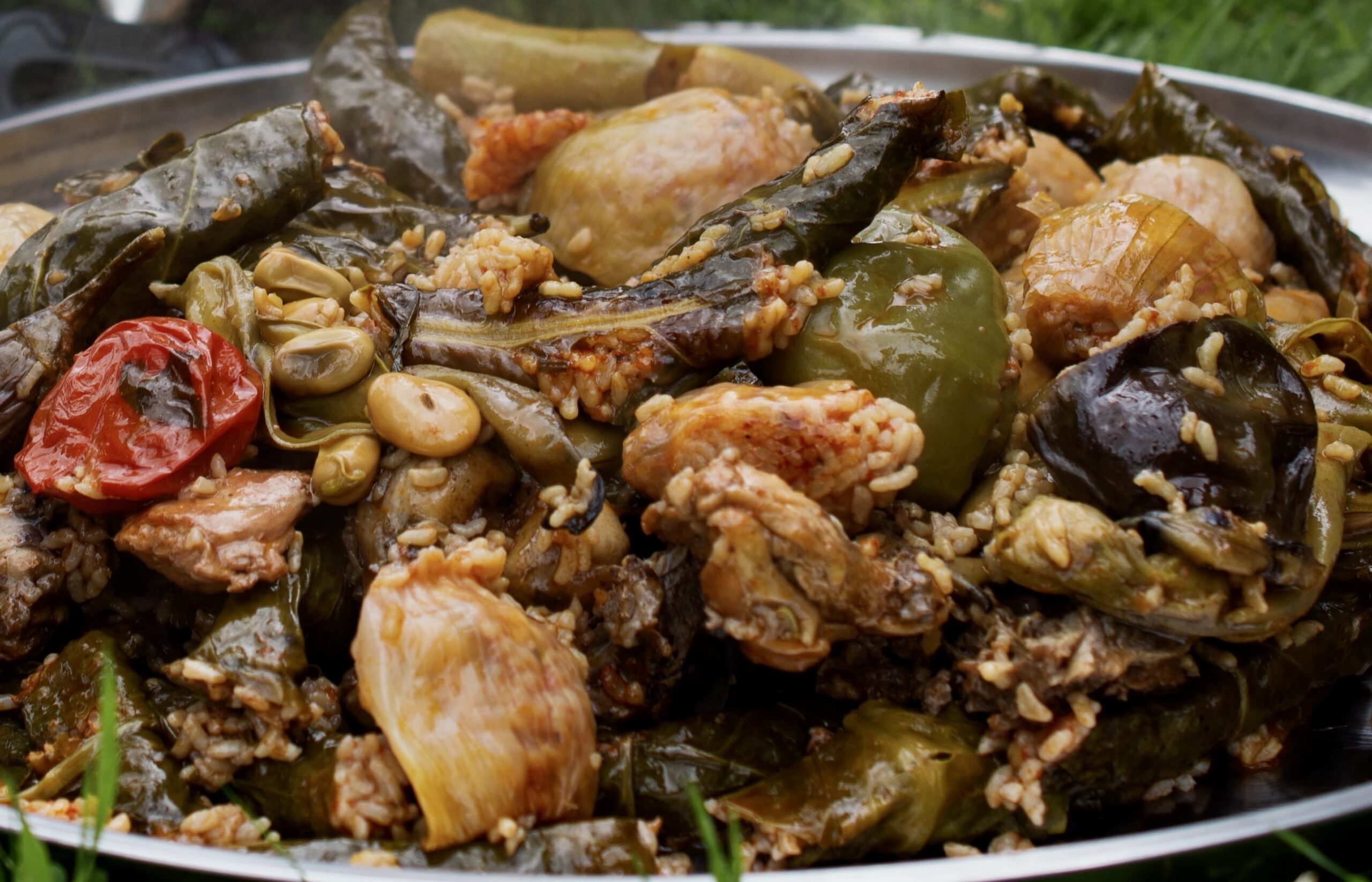
Dolmas
Vegetables or leaves that have been steamed, roasted, or boiled and then packed with minced meat, herbs, and rice. Even though we don’t typically think of Georgia when we think of dolmas, our friend Rusiko’s variation of them, which had filled fresh grape leaves from her garden, was something truly unique and delicious.

Khinkali
This type of dumpling often has ground pork and beef as the filling; however, vegetarian-friendly alternatives include Imeretian cheese, mashed potato, and mushrooms.

Chakapuli
Chakapuli is a traditional festival dish from Kakheti, a stew made with lamb and other herbs (e.g., Easter). Veal or lamb is the main ingredient in chakapuli, which is also seasoned with onions, tkemali (sour plums), white wine, garlic, and a variety of herbs.
What's the Travel Budget for Georgia
Flights
- Flights start at roughly $50 from nearby countries. Tickets however on average cost around $250 and can cost way more depending on which class and from which country you depart from.
Accommodation
- Nomad Backpacking style travelers can expect to spend around $45 for a week
- Budget travelers can expect to spend around $140 for a week
- Mid-range travelers can expect to spend around $250 for a week
- Luxury travelers can expect to spend around $660 for a week
Food Budget (Three meals and drinks)
- Nomad Backpacking style travelers can expect to spend around $11 per person per day
- Budget travelers can expect to pay around $18 per person per day
- Mid-range travelers on average would cost $20 to $30 per person per day
- Luxury travelers can expect to pay around $35 to $50 per person per day
Overall Budget Styles (Not including Flights, Tours, Transportation, or Car Rental)
- Nomad Backpacking style travelers can expect to spend roughly $150 for a week
- Budget travelers can expect to spend close to $270 for one person for a week
- Mid-range travelers can expect to spend approximately $600 for one person for a week
- Luxury travelers can expect to spend around $1,200 for one person for a wee
Flights
- Flights start at roughly $50 from nearby countries. Tickets however on average cost around $250 and can cost way more depending on which class and from which country you depart from.
Accommodation
- Nomad Backpacking style travelers can expect to spend around $45 for a week
- Budget travelers can expect to spend around $140 for a week
- Mid-range travelers can expect to spend around $250 for a week
- Luxury travelers can expect to spend around $660 for a week
Food Budget (Three meals and drinks)
- Nomad Backpacking style travelers can expect to spend around $11 per person per day
- Budget travelers can expect to pay around $18 per person per day
- Mid-range travelers on average would cost $20 to $30 per person per day
- Luxury travelers can expect to pay around $35 to $50 per person per day
Overall Budget Styles (Not including Flights, Tours, Transportation, or Car Rental)
- Nomad Backpacking style travelers can expect to spend roughly $150 for a week
- Budget travelers can expect to spend close to $270 for one person for a week
- Mid-range travelers can expect to spend approximately $600 for one person for a week
- Luxury travelers can expect to spend around $1,200 for one person for a wee
Flights
- Flights start at roughly $50 from nearby countries. Tickets however on average cost around $250 and can cost way more depending on which class and from which country you depart from.
Accommodation
- Nomad Backpacking style travelers can expect to spend around $45 for a week
- Budget travelers can expect to spend around $140 for a week
- Mid-range travelers can expect to spend around $250 for a week
- Luxury travelers can expect to spend around $660 for a week
Food Budget (Three meals and drinks)
- Nomad Backpacking style travelers can expect to spend around $11 per person per day
- Budget travelers can expect to pay around $18 per person per day
- Mid-range travelers on average would cost $20 to $30 per person per day
- Luxury travelers can expect to pay around $35 to $50 per person per day
Overall Budget Styles (Not including Flights, Tours, Transportation, or Car Rental)
- Nomad Backpacking style travelers can expect to spend roughly $150 for a week
- Budget travelers can expect to spend close to $270 for one person for a week
- Mid-range travelers can expect to spend approximately $600 for one person for a week
- Luxury travelers can expect to spend around $1,200 for one person for a wee
Flights
- Flights start at roughly $50 from nearby countries. Tickets however on average cost around $250 and can cost way more depending on which class and from which country you depart from.
Accommodation
- Nomad Backpacking style travelers can expect to spend around $45 for a week
- Budget travelers can expect to spend around $140 for a week
- Mid-range travelers can expect to spend around $250 for a week
- Luxury travelers can expect to spend around $660 for a week
Food Budget (Three meals and drinks)
- Nomad Backpacking style travelers can expect to spend around $11 per person per day
- Budget travelers can expect to pay around $18 per person per day
- Mid-range travelers on average would cost $20 to $30 per person per day
- Luxury travelers can expect to pay around $35 to $50 per person per day
Overall Budget Styles (Not including Flights, Tours, Transportation, or Car Rental)
- Nomad Backpacking style travelers can expect to spend roughly $150 for a week
- Budget travelers can expect to spend close to $270 for one person for a week
- Mid-range travelers can expect to spend approximately $600 for one person for a week
- Luxury travelers can expect to spend around $1,200 for one person for a wee
If you want to know what to pack, read this list below:
- This is a conservative country of the Caucasus with moderate climate that tends to get hot in summer and cold and rainy in winter, dress accordingly
- Raincoat or Light Waterproof Jacket
- Hiking Boots or Sturdy Sneakers (Shoes You Don’t Mind Getting Wet)
- Sunscreen
- Insect Protection – Repellent and Clothing
- Sunglasses and Sun Hat
- Water Shoes
- Beach Towels/Sarong
- Dry Bag
- Money Belt or Cross Bag
- Portable Medical Kit
- Flashlight or Headlamp
- Copies of your passport.
- Get all the needed vaccinations before traveling
- A power bank is a must in any travel.
- Always have some cash with you just in case there are no ATMs and if you are dealing with a business that solely accepts cash
- Get yourself an adapter for your gadgets
- 1 toothbrush
- 1 tube of toothpaste
- 1 razor
- 1 package of dental floss
- 1 small bottle of shampoo
- 1 small bottle of shower gel
- 1 towel
- Deodorant
- Band-Aids
- Hydrocortisone cream
- Antibacterial cream
- Earplugs
- Tylenol
- Hand sanitizer (germs = sick = bad holiday)
- A key or combination lock
- Zip-lock bags
- Plastic bags (great for laundry)
- Universal charger/adaptor
- LifeStraw (A water bottle with a purifier)
- 1 dry shampoo spray & talc powder
- 1 hairbrush
- Makeup you use
- Hairbands & hair clips
- Feminine hygiene products
Clothing For Boys
- 1 pair of jeans or khaki pants
- 1 pair of shorts
- 1 bathing suit
- 5 T-shirts
- 1 long-sleeved T-shirt
- 1 pair of flip-flops
- 1 pair of sneakers
- 6 pairs of socks
- 5 pairs of boxer shorts
Clothing For Girls
- 1 swimsuit
- 1 sarong
- 1 pair of stretchy jeans
- 1 pair of leggings
- 2-3 long-sleeve tops
- 2-3 T-shirts
- 3-4 spaghetti tops
- 1 light cardigan
Want to plan your own trip, here are some of the best resources that can help you
- Skyscanner – They search small websites and budget airlines that larger search sites tend to miss. They are hands down the number one place to start.
- Momondo – This is another favorite flight search engine because they search such a wide variety of sites and airlines. Always check here too.
- Booking.com – The best all-around booking site that constantly provides the most affordable and lowest rates. They have the widest selection of budget accommodation.
- Couchsurfing – This website allows you to stay on people’s couches or spare rooms for free. It’s a great way to save money while meeting locals who can tell you the ins and outs of their city. The site also lists events you can attend to meet people (even if you’re not staying with someone).
- Intrepid Travel – If you want to do group tours, go with Intrepid. They offer good small group tours that use local operators and leave a small environmental footprint.
- Grassroots Volunteering – For volunteering, Grassroots Volunteering compiles a list of good local volunteer organizations that keep the money within the community.
- Get Your Guide – Get Your Guide is a huge online marketplace for tours and excursions. They have tons of tour options available in cities all around the world, including everything from cooking classes, walking tours, street art lessons, and more! It has the world’s largest collection of things to do with more than 30,000 activities in 7500 destinations.
- SafetyWing – Safety Wing offers convenient and affordable plans tailored to digital nomads and long-term travelers. They have cheap monthly plans, great customer service, and an easy-to-use claims process that makes it perfect for those on the road.
- Trip Advisor: Check the reviews and then book your accommodation. TripAdvisor is where you go when you want to compare prices with multiple accommodation providers.
- VRBO: is the main search engine to use when you are looking for a home or apartment rental. It can sometimes be cheaper than hotels and it is the best way to stay in areas that offer a more local feel.
- Hostelworld: With one of the largest databases of hostels in the world, Hostelworld is the go-to site when you are looking for budget accommodation.
- Rome 2 Rio: If you want to see how to get somewhere by plane, train, bus, ferry, or car Rome2Rio lays it all out for you as well as related costs.
- World Nomads Insurance: When traveling you should always have travel insurance. We have found the best bang for your buck is by far World Nomads.
Final Thoughts on Georgia
Legacy seen through traditional buildings and the countryside with a greatly diverse culture, stunning and unusual landmarks, some of which are pilgrimage sites, unbelievable warmth despite the cooler weather, exciting tunes and festivities, and vivid picture-perfect surroundings of highlands and pristine beaches best for kicking back and watching the sunsets all contribute to Georgia’s allure. Georgia’s recorded history dates back to 3,000 BC and evidence that shows it goes way more back than that. Among the best places to visit at the crossroads of several civilizations, right in the middle between Europe and Asia. Georgia is a traveler’s paradise due to its breathtaking landscapes, diverse wildlife, and fascinating historical monuments, all of which are just starting to be known. Interested in visiting Georgia?
Have you ever been to Georgia? Leave your comments or questions in the section below.
1 Comment
Wow that was odd. I jus wrote aan verry long comment buut after
I clicked submit myy comment didn’t show up. Grrrr…
well I’m noot writing alll that over again. Anyhow, just wanted to say great blog!